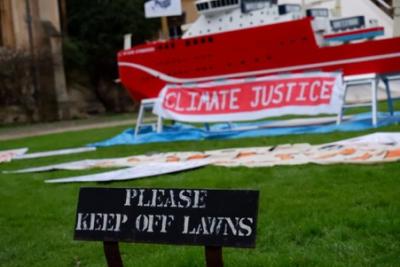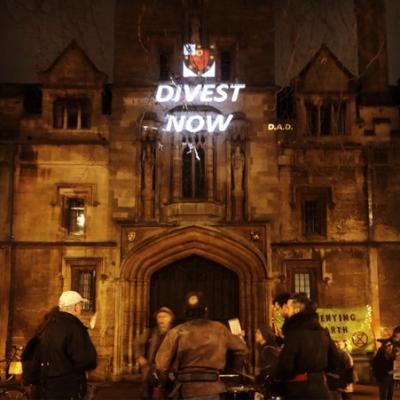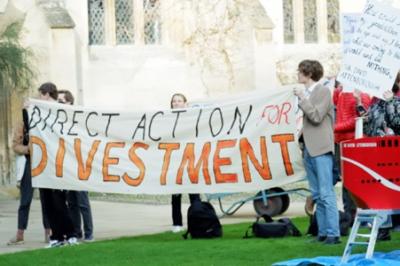Direct Action for Divestment and the Right to Peaceful Protest on Private Property
Posted:
Time to read:
Last month, a group of Oxford students occupied the Front Quad of St John’s College for five days, protesting against the college’s continued investment into fossil fuel companies. The demonstrators eventually left the quad voluntarily, stating that they had succeeded ‘in reigniting a conversation

The protests raise interesting legal questions as to the circumstances in which ownership rights might be qualified by other fundamental rights. Let us imagine that St John’s had decided to initiate legal proceedings to have the demonstrators forcibly removed. Would the students have been able to resist expulsion on the grounds that to eject them would amount to a disproportionate interference with their rights to freedom of expression (Article 10 ECHR) and freedom of association (Article 11 ECHR) under the European Convention of Human Rights?
Oxford colleges are best analysed as ‘hybrid public authorities’ for the purposes of the Human Rights Act 1998. (Aston Cantlow v Wallbank

In Appleby v UK (2003) 37 EHRR 38), the applicants were prevented from distributing leaflets in a privately-owned town centre. The ECtHR accepted that the protestors Article 10 and 11 rights were engaged and that, in principle, the state might owe a positive obligation to protect these rights against interferences by others. It did not, however, find a violation on these facts. The restrictions did not have the effect of ‘preventing any effective exercise of freedom of expression.’ The ‘essence of the right’ was preserved since, by the applicant’s own admission, the campaign could have been carried out elsewhere in town, or through other means ‘such as calling door-to-door or seeking exposure in the local press, radio and television.’ The reasoning in Appleby accordingly suggests that a fundamental right to access private property for the purposes of peaceful protest can be envisaged ‘only in the most extreme circumstances.’ (Mead, 187.)
On facts more closely analogous to the present, in SOAS v. Persons Unknown (25 November 2010, unreported), Henderson J bluntly stated that ‘‘[t]he proposition that the law requires the property rights of SOAS to be overridden in their own building is unarguable.’

Nonetheless, although the availability of alternatives clearly ought plainly to be a relevant consideration in balancing the competing rights and interest involved, Mead (p.134) has persuasively argued that Appleby ‘underplays the importance of autonomy and choice in determining content and forms of expressive activities,’ and ‘ignores the fact that a chosen location may be ‘uniquely positioned’, or have a ‘close connection’ and ‘symbolic importance’ to the protest.
A nigh-unfettered right to exclude, even for private landowners, represents an over-simplistic solution which gives insufficient weight to the importance of a right of access as a corollary to effective democratic participation and free discourse in the public sphere. As noted by Lamer J, ‘freedom of expression cannot be exercised in a vacuum…it necessarily implies the use of physical space in order to meet its underlying objectives.’ (Committee for the Commonwealth of Canada v Canada (1991) 77 DLR (4th) 385, 394 (Canadian Supreme Court))
A binary division between public and privately held land for these purposes fails to distinguish between the diverse contexts in which land is privately owned. In Appleby (at para 44), the ECtHR itself recognised that the shopping centre could be regarded as a ‘quasi-public space’ which, alongside its primary commercial function, served as a gathering place in which individuals are ‘encouraged to linger and participate in a wide range of activities – from entertainment to community, educational and charitable events.’ Notwithstanding the appearances created by their imposing gate towers and crenellated walls, as a matter of substance, Oxford colleges could be distinguished from the aphorism that an ‘Englishman’s home is his castle’ on similar grounds. Though the public at large might not typically congregate in the enclosed college quads, students and fellows certainly do. In rethinking this area of the law, we must also examine the interrelationships between: (a) the physical space, (b) the subject of the demonstration, and (c) the persons involved. The language of ‘quasi-public’ has strong intuitive appeal and features heavily in the jurisprudence in this area. One of the risks of adopting this terminology, however, is that it fails to truly move beyond the public / private distinction which it is perhaps designed to overcome, and itself elides the nuanced and diverse ways in which land is owned and used.
As recognised by Judge Maruste (partly dissenting) in Appleby: ‘it would clearly be too far-reaching to say that no limitations can be put on the exercise of rights and freedoms on private land or premises,’ yet ‘the old traditional rule that the private owner has an unfettered right to eject people from his land and premises without giving any justification and without any test of reasonableness being applied is no longer fully adapted to contemporary conditions and society.’ Though it is unimaginable that the rights to peaceful protest could ever justify a permanent or unconditional right of occupation for protestors, on fact patterns such as the present, it is submitted that private landowners ought to be required to tolerate non-disruptive protests on a temporary basis.
It is tentatively submitted that, notwithstanding the fact that courts seem to uniformly prioritise property rights over the protestor’s rights to freedom of expression and association, there is more support in the case law for such a proposition than might appear at first sight. In numerous cases, such as in City of London v Samede [2012] EWHC 34 (QB) and in University of Sussex v Persons Unknown (above), courts have emphasised that protests had already continued for some time. Perhaps the protestors had simply already been afforded sufficient opportunity by the landowners to have their say.
__________
How to cite this blog post (Harvard style)
Koch, T. (2020). Direct Action for Divestment and the Right to Peaceful Protest on Private Property. Available at: https://www.law.ox.ac.uk/research-and-subject-groups/property-law/blog/2020/03/direct-action-divestment-and-right-peaceful (Accessed [date]).
Share:
